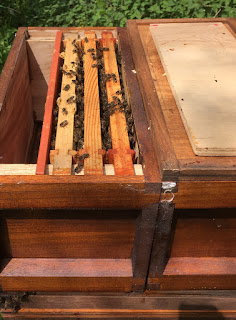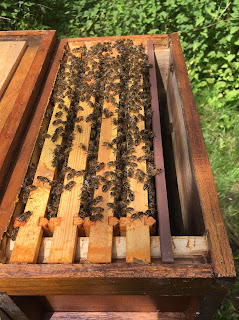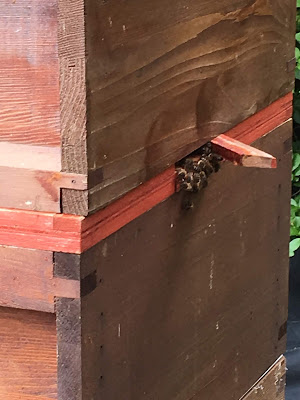Why would you want to use frames without foundation? Well there are a number of possible reasons:
1. You save on the cost of buying foundation. We beekeepers are known for our frugality are we not?
2. The bees can build the type of comb that they wish, worker or drone comb.
3. If you insert the foundationless frames when the bees are trying to build drone comb, on a flow they will build a complete frame of drone comb. Knowing this can be useful in two ways:
a) If you're queen rearing queens, you will want drones from your best colonies with which your new queens can mate with. By encouraging drone production in your best colonies you are directly effecting the quality of not just your new queens but those of your neighbours too, which will benefit you in return in subsequent years.
b) By encouraging the colony to build a complete fame of drone comb it can then, once this is capped, be opened, inspected for varroa infestation loads and if high the whole comb can be removed and destroyed. Therefore removing a large portion of the varroa population. Cut out the comb using a knife or the edge of you hive tool and replace the frame, the bees will draw out more comb. This can be used in reverse to that above, colonies that are not particularly desirable can have drone removed so that their contribution to the gene pool is reduced, prior to their re queening.
4. Swarm prevention! I have on a few occasions dissuaded a colony that had started queen cells from swarming for a while by placing foundation less frames in the brood area. The bees draw these frame very quickly, much faster than foundation, it does not introduce a barrier to the movement of the queen within the hive and the queen will lay in this new comb almost as it is drawn, immediately providing more space within the brood nest.
Why wouldn't you want to use founationless frames?
1. Well for a start, your hives must be level! The bees draw out the comb hanging from the top bar, it will always be vertical because that's what gravity does. If your other frames are on the tilt, because your hive is, it will cause problems.
2. Too much drone comb will according to some promote varroa population growth.
How do you prepare foundation less frames?
I initially used thin (1mm) balsa wood, bought from craft suppliers, these came in 4 inch by 2ft sheets that needed to be cut to widths of about 1 to 1.5 mm which is time consuming, these strips of balsa would then be fixed with glue and pinned through from the foundation retaining strip where the foundation would usually go.
I now use tongue depressors, as used by dentists these are readily available on line at Amazon and similar web sites.
These are simply glued into the slot on the top bar with a thin bead of PVA glue.
This takes no time at all to do.
There is no need for pins, the bees propalise all spaces fixing everything in place.
The bees will festoon from the top bars and build comb quickly. Initially the comb will look something like this:
Later, as the frame is filled the bees will respect bee space leaving a gap between the comb and the side and bottom bars.
At this point it is important to always keep the comb vertical. It is not supported from either the side or bottom bars and may hold brood and nectar that has considerable weight. If the comb is held horizontally it will bend and probably break off!
For inspections the frame should be held by the frame lugs and rotated 90 degrees so that the top bar is now vertical. Rotate the frame about the top bar away from you. Next rotate the frame 90 degrees in the opposite direction to your initial manoeuvre. You will now be looking at the reverse face of the comb, the top bar now being the lower edge of the frame. During this procedure the comb has not moved from the vertical axis. Try it a few times with an empty frame, its really rather easier in practice than it sounds.
Pinching some comb between your fingers and stretching a small portion towards the frame edges breaks bee space and encourages the bees to fix the comb to the frame.
I use British Standard frames and this method works well with these. If however you use 14x12 or other larger format frames then extra support will be required due to the extra area and hence weight of the comb. This is usually given by fixing two lengths of steel wire or fishing line between the side bars. This becomes incorporated into the comb adding strength.
I have used this method on super frames and found them to be just as robust when the honey has been extracted.
This is what you will end up with, natural, pure bees wax comb that queens just love to lay into.
By the way, can you see the queen on this frame? She is there.
So why not give it a go? Positively influence your local gene pool by breeding drone from your best stock or keep your varroa levels in check without using chemicals!
 |
| Drone Comb |













